Bentley's Leadership & Management: Operational Efficiencies Analysis
VerifiedAdded on 2024/05/20
|28
|5329
|345
Report
AI Summary
This report provides an in-depth analysis of leadership and management roles within Bentley Motors, a British car manufacturer acquired by Volkswagen. It defines and compares the roles of leaders and managers, applying various management theories such as Mintzberg's management roles to understand their functions. The report examines how these roles apply in different situational contexts, particularly focusing on the impact of rising raw material costs and production activities. Different leadership styles, including directive, supportive, participative, and achievement-oriented, are explored in relation to Robert House's leadership styles. The importance of operations management in achieving business objectives is highlighted, along with an evaluation of how leaders and managers can improve operational efficiencies. Finally, the report assesses the factors within the organization's environment that may impact operational management and decision-making by leaders and managers, analyzing the relationship between leadership and management and its effect on the business environment and wider community. Desklib provides access to this and other solved assignments for students.
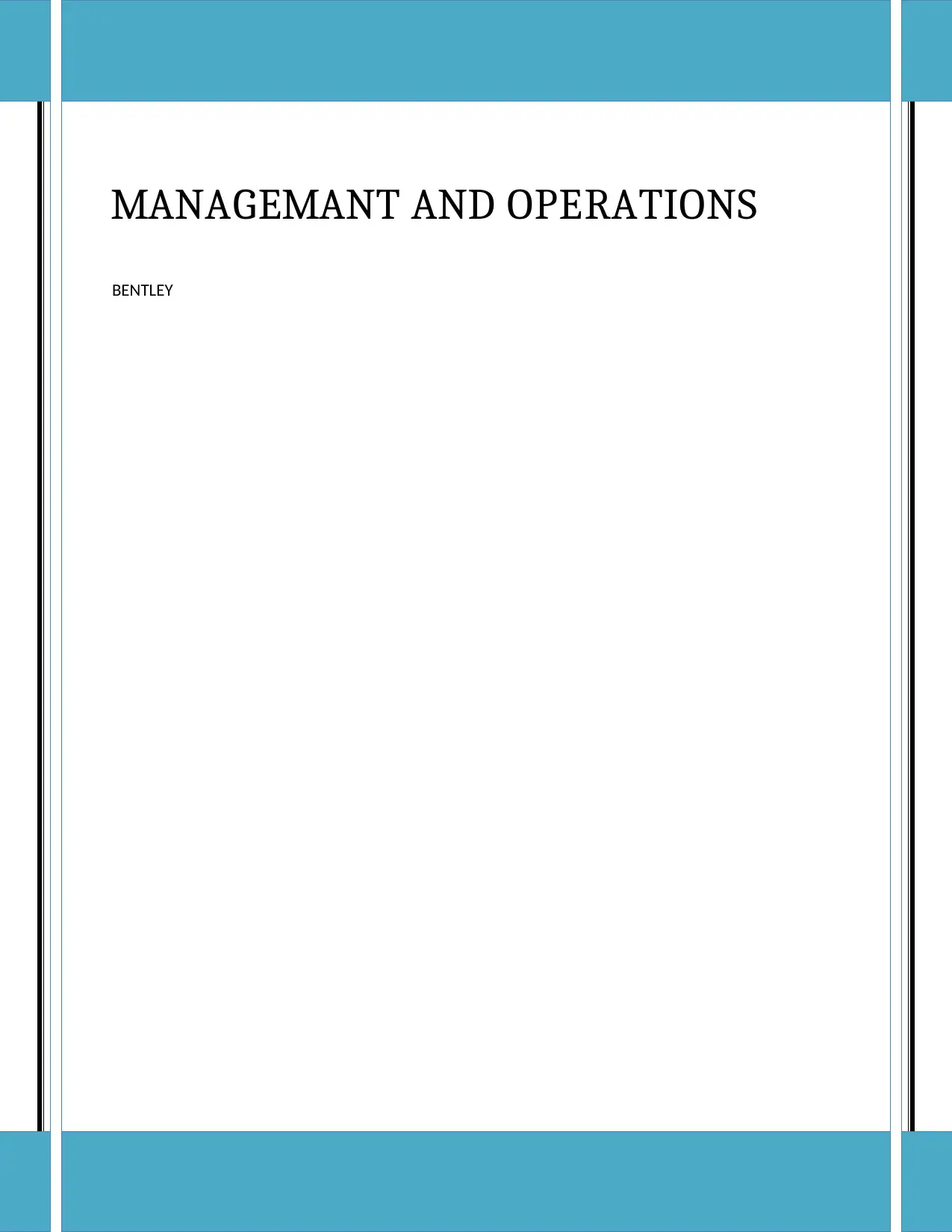
MANAGEMANT AND OPERATIONS
BENTLEY
BENTLEY
Paraphrase This Document
Need a fresh take? Get an instant paraphrase of this document with our AI Paraphraser
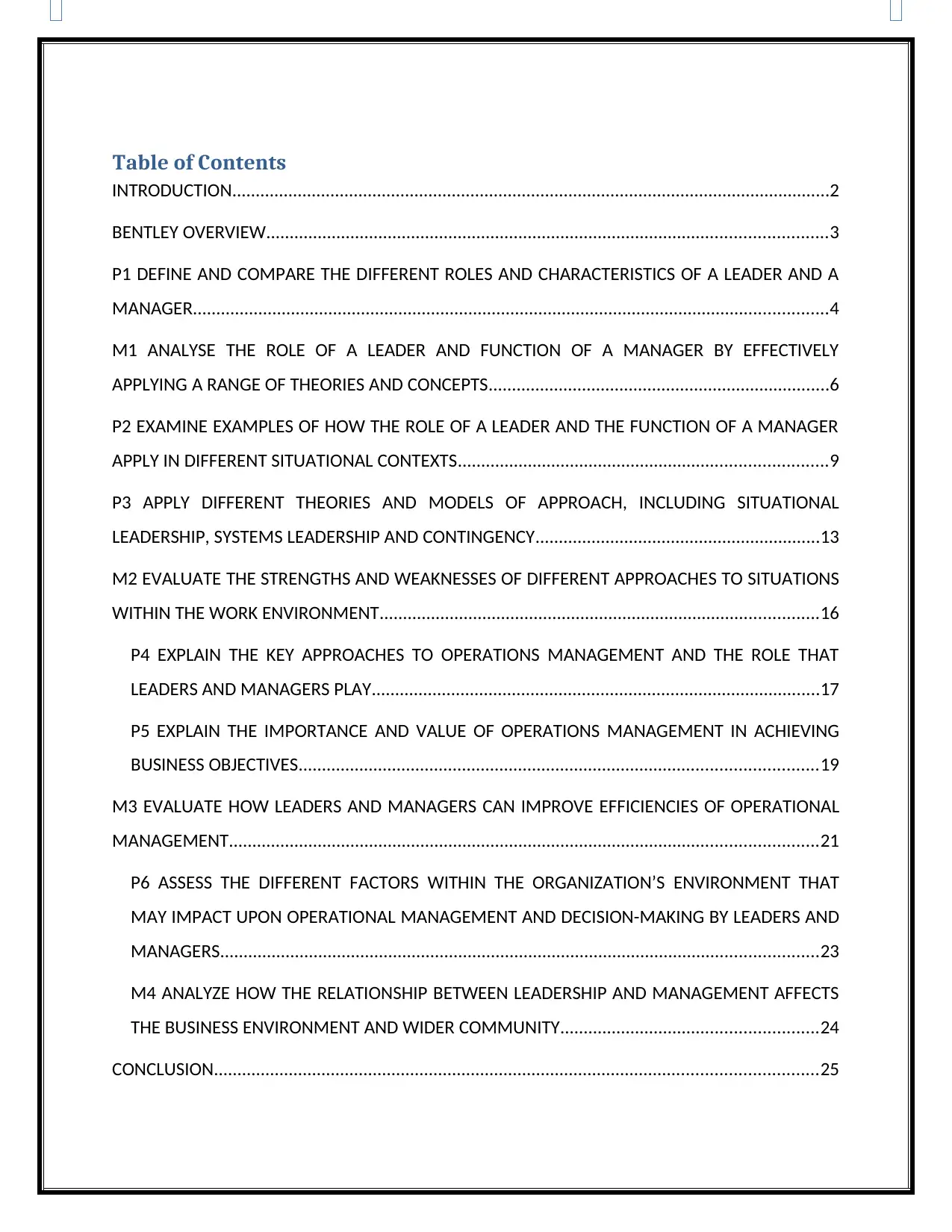
Table of Contents
INTRODUCTION................................................................................................................................2
BENTLEY OVERVIEW........................................................................................................................3
P1 DEFINE AND COMPARE THE DIFFERENT ROLES AND CHARACTERISTICS OF A LEADER AND A
MANAGER........................................................................................................................................4
M1 ANALYSE THE ROLE OF A LEADER AND FUNCTION OF A MANAGER BY EFFECTIVELY
APPLYING A RANGE OF THEORIES AND CONCEPTS.........................................................................6
P2 EXAMINE EXAMPLES OF HOW THE ROLE OF A LEADER AND THE FUNCTION OF A MANAGER
APPLY IN DIFFERENT SITUATIONAL CONTEXTS...............................................................................9
P3 APPLY DIFFERENT THEORIES AND MODELS OF APPROACH, INCLUDING SITUATIONAL
LEADERSHIP, SYSTEMS LEADERSHIP AND CONTINGENCY.............................................................13
M2 EVALUATE THE STRENGTHS AND WEAKNESSES OF DIFFERENT APPROACHES TO SITUATIONS
WITHIN THE WORK ENVIRONMENT..............................................................................................16
P4 EXPLAIN THE KEY APPROACHES TO OPERATIONS MANAGEMENT AND THE ROLE THAT
LEADERS AND MANAGERS PLAY................................................................................................17
P5 EXPLAIN THE IMPORTANCE AND VALUE OF OPERATIONS MANAGEMENT IN ACHIEVING
BUSINESS OBJECTIVES...............................................................................................................19
M3 EVALUATE HOW LEADERS AND MANAGERS CAN IMPROVE EFFICIENCIES OF OPERATIONAL
MANAGEMENT..............................................................................................................................21
P6 ASSESS THE DIFFERENT FACTORS WITHIN THE ORGANIZATION’S ENVIRONMENT THAT
MAY IMPACT UPON OPERATIONAL MANAGEMENT AND DECISION-MAKING BY LEADERS AND
MANAGERS................................................................................................................................23
M4 ANALYZE HOW THE RELATIONSHIP BETWEEN LEADERSHIP AND MANAGEMENT AFFECTS
THE BUSINESS ENVIRONMENT AND WIDER COMMUNITY.......................................................24
CONCLUSION.................................................................................................................................25
INTRODUCTION................................................................................................................................2
BENTLEY OVERVIEW........................................................................................................................3
P1 DEFINE AND COMPARE THE DIFFERENT ROLES AND CHARACTERISTICS OF A LEADER AND A
MANAGER........................................................................................................................................4
M1 ANALYSE THE ROLE OF A LEADER AND FUNCTION OF A MANAGER BY EFFECTIVELY
APPLYING A RANGE OF THEORIES AND CONCEPTS.........................................................................6
P2 EXAMINE EXAMPLES OF HOW THE ROLE OF A LEADER AND THE FUNCTION OF A MANAGER
APPLY IN DIFFERENT SITUATIONAL CONTEXTS...............................................................................9
P3 APPLY DIFFERENT THEORIES AND MODELS OF APPROACH, INCLUDING SITUATIONAL
LEADERSHIP, SYSTEMS LEADERSHIP AND CONTINGENCY.............................................................13
M2 EVALUATE THE STRENGTHS AND WEAKNESSES OF DIFFERENT APPROACHES TO SITUATIONS
WITHIN THE WORK ENVIRONMENT..............................................................................................16
P4 EXPLAIN THE KEY APPROACHES TO OPERATIONS MANAGEMENT AND THE ROLE THAT
LEADERS AND MANAGERS PLAY................................................................................................17
P5 EXPLAIN THE IMPORTANCE AND VALUE OF OPERATIONS MANAGEMENT IN ACHIEVING
BUSINESS OBJECTIVES...............................................................................................................19
M3 EVALUATE HOW LEADERS AND MANAGERS CAN IMPROVE EFFICIENCIES OF OPERATIONAL
MANAGEMENT..............................................................................................................................21
P6 ASSESS THE DIFFERENT FACTORS WITHIN THE ORGANIZATION’S ENVIRONMENT THAT
MAY IMPACT UPON OPERATIONAL MANAGEMENT AND DECISION-MAKING BY LEADERS AND
MANAGERS................................................................................................................................23
M4 ANALYZE HOW THE RELATIONSHIP BETWEEN LEADERSHIP AND MANAGEMENT AFFECTS
THE BUSINESS ENVIRONMENT AND WIDER COMMUNITY.......................................................24
CONCLUSION.................................................................................................................................25
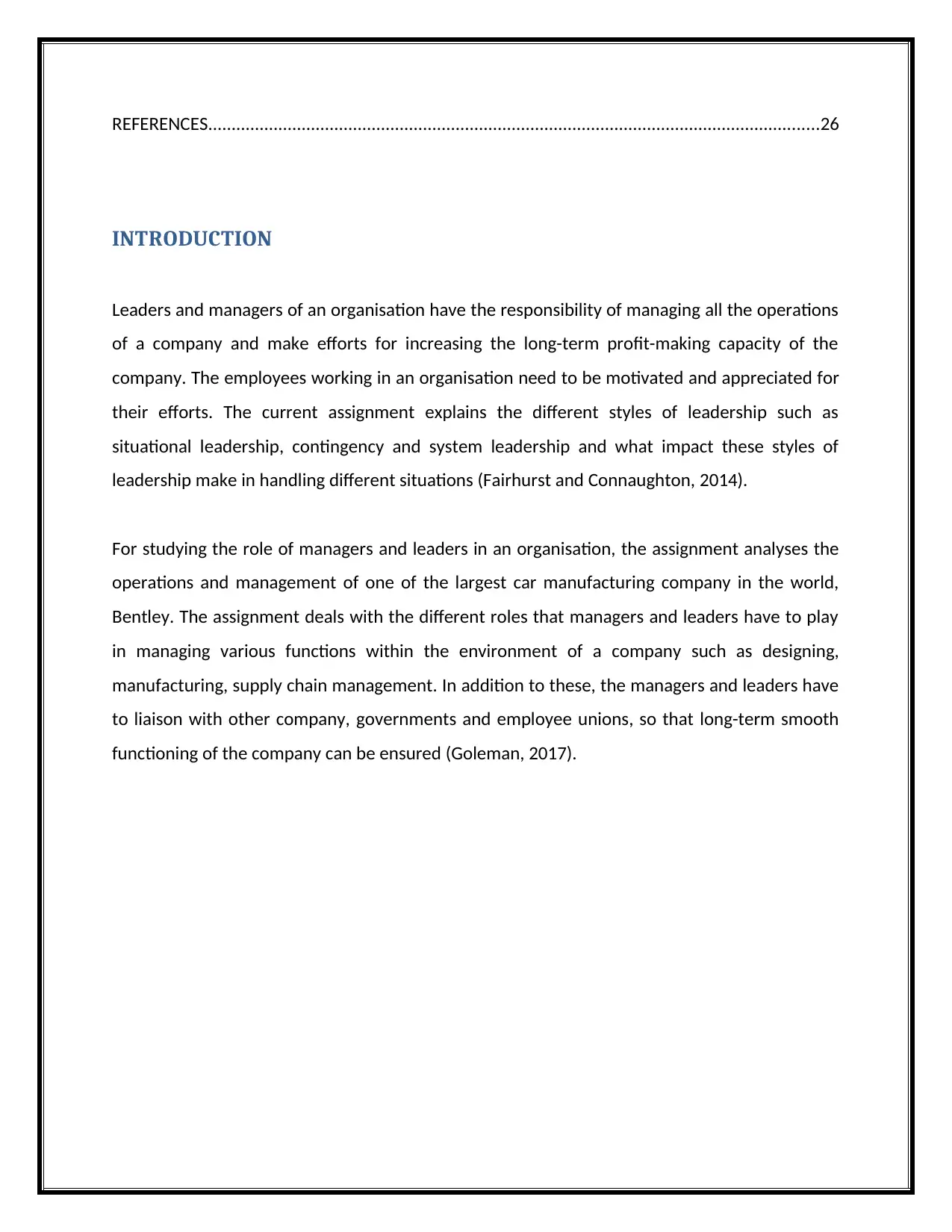
REFERENCES...................................................................................................................................26
INTRODUCTION
Leaders and managers of an organisation have the responsibility of managing all the operations
of a company and make efforts for increasing the long-term profit-making capacity of the
company. The employees working in an organisation need to be motivated and appreciated for
their efforts. The current assignment explains the different styles of leadership such as
situational leadership, contingency and system leadership and what impact these styles of
leadership make in handling different situations (Fairhurst and Connaughton, 2014).
For studying the role of managers and leaders in an organisation, the assignment analyses the
operations and management of one of the largest car manufacturing company in the world,
Bentley. The assignment deals with the different roles that managers and leaders have to play
in managing various functions within the environment of a company such as designing,
manufacturing, supply chain management. In addition to these, the managers and leaders have
to liaison with other company, governments and employee unions, so that long-term smooth
functioning of the company can be ensured (Goleman, 2017).
INTRODUCTION
Leaders and managers of an organisation have the responsibility of managing all the operations
of a company and make efforts for increasing the long-term profit-making capacity of the
company. The employees working in an organisation need to be motivated and appreciated for
their efforts. The current assignment explains the different styles of leadership such as
situational leadership, contingency and system leadership and what impact these styles of
leadership make in handling different situations (Fairhurst and Connaughton, 2014).
For studying the role of managers and leaders in an organisation, the assignment analyses the
operations and management of one of the largest car manufacturing company in the world,
Bentley. The assignment deals with the different roles that managers and leaders have to play
in managing various functions within the environment of a company such as designing,
manufacturing, supply chain management. In addition to these, the managers and leaders have
to liaison with other company, governments and employee unions, so that long-term smooth
functioning of the company can be ensured (Goleman, 2017).
⊘ This is a preview!⊘
Do you want full access?
Subscribe today to unlock all pages.

Trusted by 1+ million students worldwide
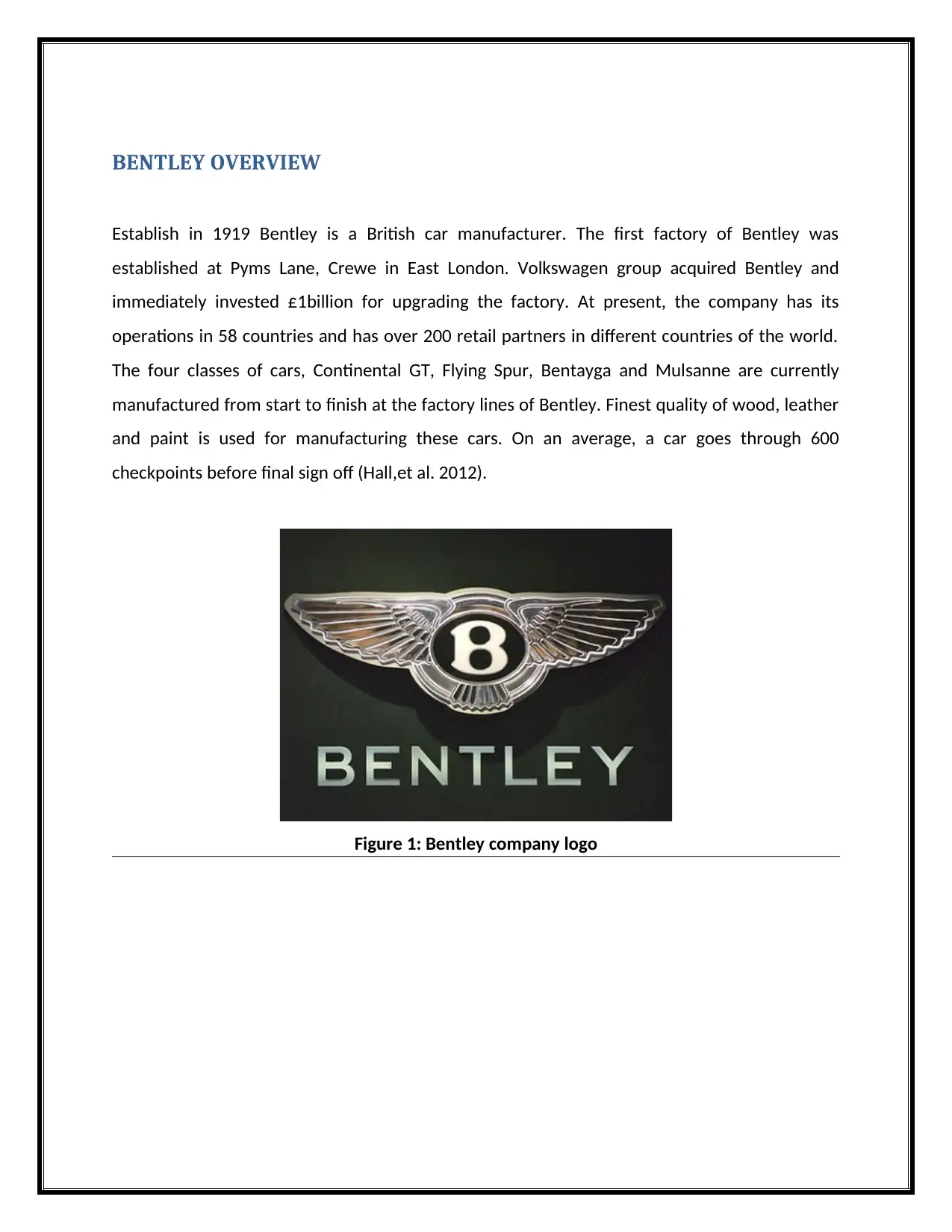
BENTLEY OVERVIEW
Establish in 1919 Bentley is a British car manufacturer. The first factory of Bentley was
established at Pyms Lane, Crewe in East London. Volkswagen group acquired Bentley and
immediately invested £1billion for upgrading the factory. At present, the company has its
operations in 58 countries and has over 200 retail partners in different countries of the world.
The four classes of cars, Continental GT, Flying Spur, Bentayga and Mulsanne are currently
manufactured from start to finish at the factory lines of Bentley. Finest quality of wood, leather
and paint is used for manufacturing these cars. On an average, a car goes through 600
checkpoints before final sign off (Hall,et al. 2012).
Figure 1: Bentley company logo
Establish in 1919 Bentley is a British car manufacturer. The first factory of Bentley was
established at Pyms Lane, Crewe in East London. Volkswagen group acquired Bentley and
immediately invested £1billion for upgrading the factory. At present, the company has its
operations in 58 countries and has over 200 retail partners in different countries of the world.
The four classes of cars, Continental GT, Flying Spur, Bentayga and Mulsanne are currently
manufactured from start to finish at the factory lines of Bentley. Finest quality of wood, leather
and paint is used for manufacturing these cars. On an average, a car goes through 600
checkpoints before final sign off (Hall,et al. 2012).
Figure 1: Bentley company logo
Paraphrase This Document
Need a fresh take? Get an instant paraphrase of this document with our AI Paraphraser
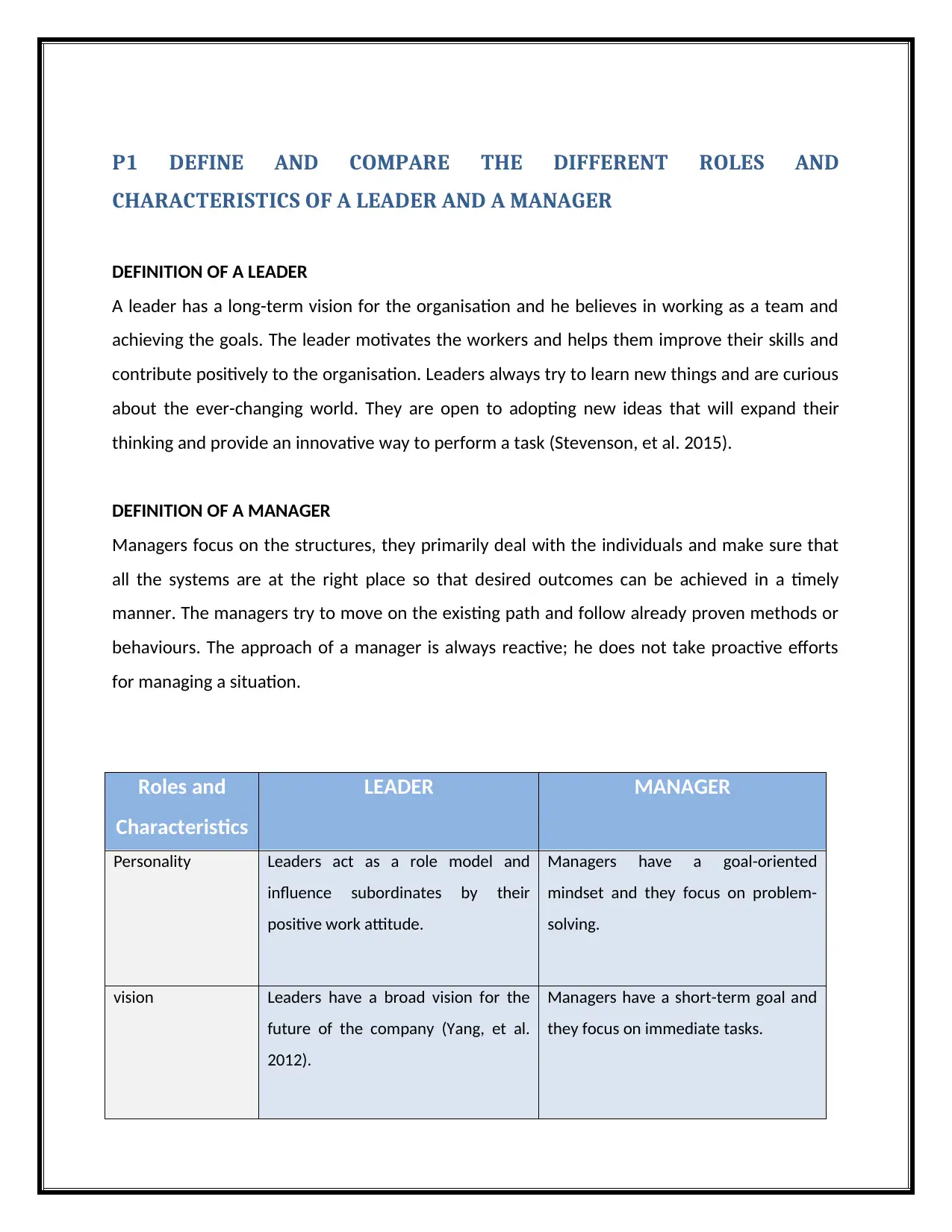
P1 DEFINE AND COMPARE THE DIFFERENT ROLES AND
CHARACTERISTICS OF A LEADER AND A MANAGER
DEFINITION OF A LEADER
A leader has a long-term vision for the organisation and he believes in working as a team and
achieving the goals. The leader motivates the workers and helps them improve their skills and
contribute positively to the organisation. Leaders always try to learn new things and are curious
about the ever-changing world. They are open to adopting new ideas that will expand their
thinking and provide an innovative way to perform a task (Stevenson, et al. 2015).
DEFINITION OF A MANAGER
Managers focus on the structures, they primarily deal with the individuals and make sure that
all the systems are at the right place so that desired outcomes can be achieved in a timely
manner. The managers try to move on the existing path and follow already proven methods or
behaviours. The approach of a manager is always reactive; he does not take proactive efforts
for managing a situation.
Roles and
Characteristics
LEADER MANAGER
Personality Leaders act as a role model and
influence subordinates by their
positive work attitude.
Managers have a goal-oriented
mindset and they focus on problem-
solving.
vision Leaders have a broad vision for the
future of the company (Yang, et al.
2012).
Managers have a short-term goal and
they focus on immediate tasks.
CHARACTERISTICS OF A LEADER AND A MANAGER
DEFINITION OF A LEADER
A leader has a long-term vision for the organisation and he believes in working as a team and
achieving the goals. The leader motivates the workers and helps them improve their skills and
contribute positively to the organisation. Leaders always try to learn new things and are curious
about the ever-changing world. They are open to adopting new ideas that will expand their
thinking and provide an innovative way to perform a task (Stevenson, et al. 2015).
DEFINITION OF A MANAGER
Managers focus on the structures, they primarily deal with the individuals and make sure that
all the systems are at the right place so that desired outcomes can be achieved in a timely
manner. The managers try to move on the existing path and follow already proven methods or
behaviours. The approach of a manager is always reactive; he does not take proactive efforts
for managing a situation.
Roles and
Characteristics
LEADER MANAGER
Personality Leaders act as a role model and
influence subordinates by their
positive work attitude.
Managers have a goal-oriented
mindset and they focus on problem-
solving.
vision Leaders have a broad vision for the
future of the company (Yang, et al.
2012).
Managers have a short-term goal and
they focus on immediate tasks.
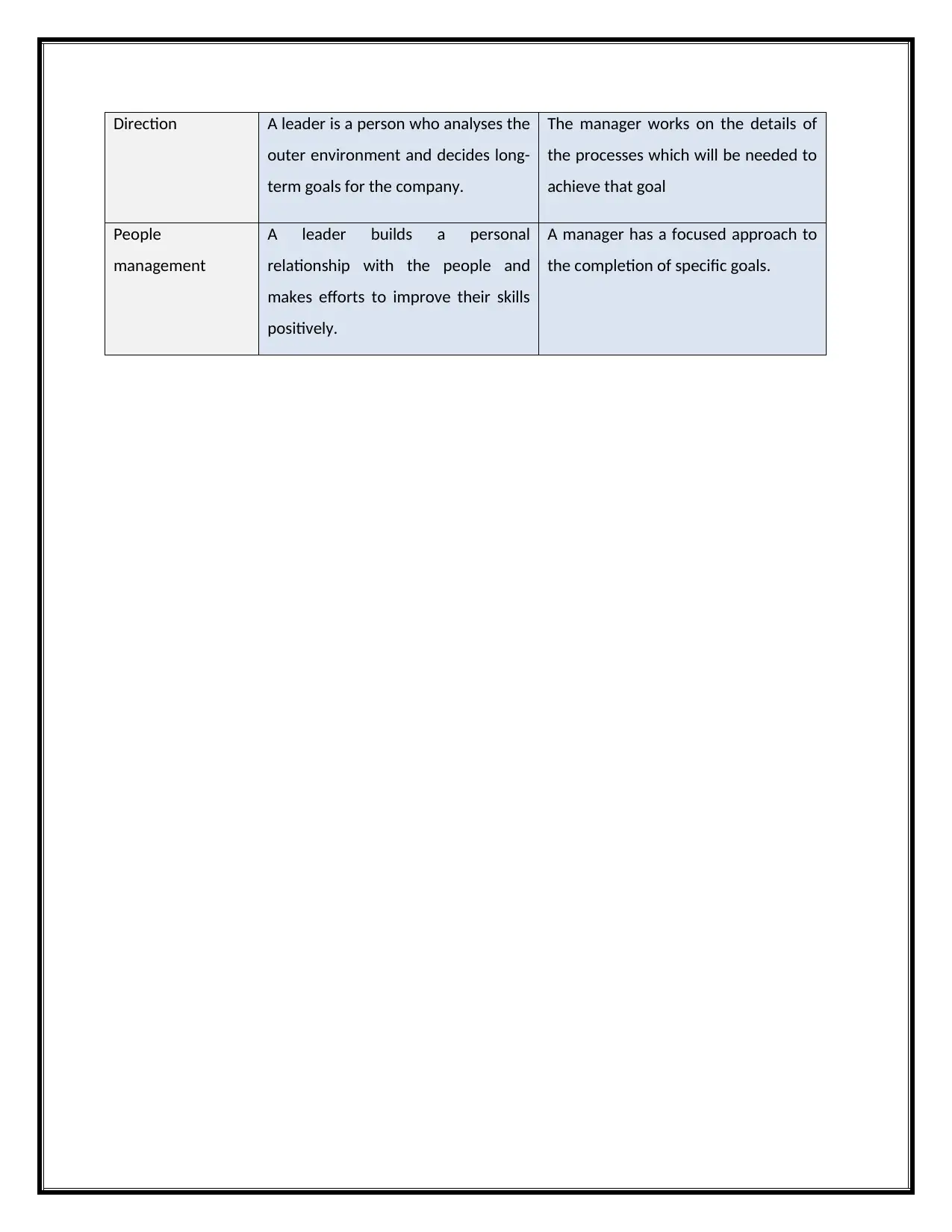
Direction A leader is a person who analyses the
outer environment and decides long-
term goals for the company.
The manager works on the details of
the processes which will be needed to
achieve that goal
People
management
A leader builds a personal
relationship with the people and
makes efforts to improve their skills
positively.
A manager has a focused approach to
the completion of specific goals.
outer environment and decides long-
term goals for the company.
The manager works on the details of
the processes which will be needed to
achieve that goal
People
management
A leader builds a personal
relationship with the people and
makes efforts to improve their skills
positively.
A manager has a focused approach to
the completion of specific goals.
⊘ This is a preview!⊘
Do you want full access?
Subscribe today to unlock all pages.

Trusted by 1+ million students worldwide
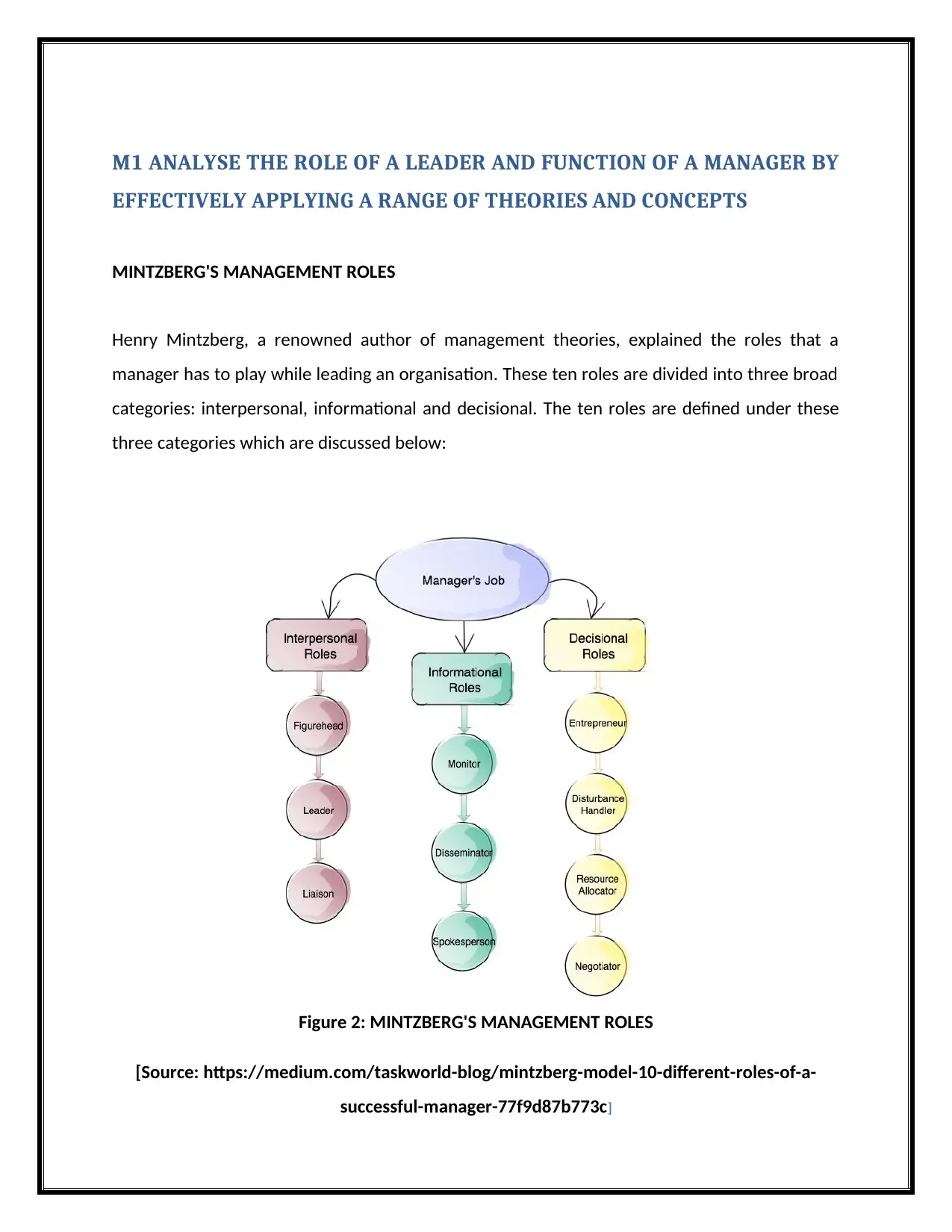
M1 ANALYSE THE ROLE OF A LEADER AND FUNCTION OF A MANAGER BY
EFFECTIVELY APPLYING A RANGE OF THEORIES AND CONCEPTS
MINTZBERG'S MANAGEMENT ROLES
Henry Mintzberg, a renowned author of management theories, explained the roles that a
manager has to play while leading an organisation. These ten roles are divided into three broad
categories: interpersonal, informational and decisional. The ten roles are defined under these
three categories which are discussed below:
Figure 2: MINTZBERG'S MANAGEMENT ROLES
[Source: https://medium.com/taskworld-blog/mintzberg-model-10-different-roles-of-a-
successful-manager-77f9d87b773c]
EFFECTIVELY APPLYING A RANGE OF THEORIES AND CONCEPTS
MINTZBERG'S MANAGEMENT ROLES
Henry Mintzberg, a renowned author of management theories, explained the roles that a
manager has to play while leading an organisation. These ten roles are divided into three broad
categories: interpersonal, informational and decisional. The ten roles are defined under these
three categories which are discussed below:
Figure 2: MINTZBERG'S MANAGEMENT ROLES
[Source: https://medium.com/taskworld-blog/mintzberg-model-10-different-roles-of-a-
successful-manager-77f9d87b773c]
Paraphrase This Document
Need a fresh take? Get an instant paraphrase of this document with our AI Paraphraser
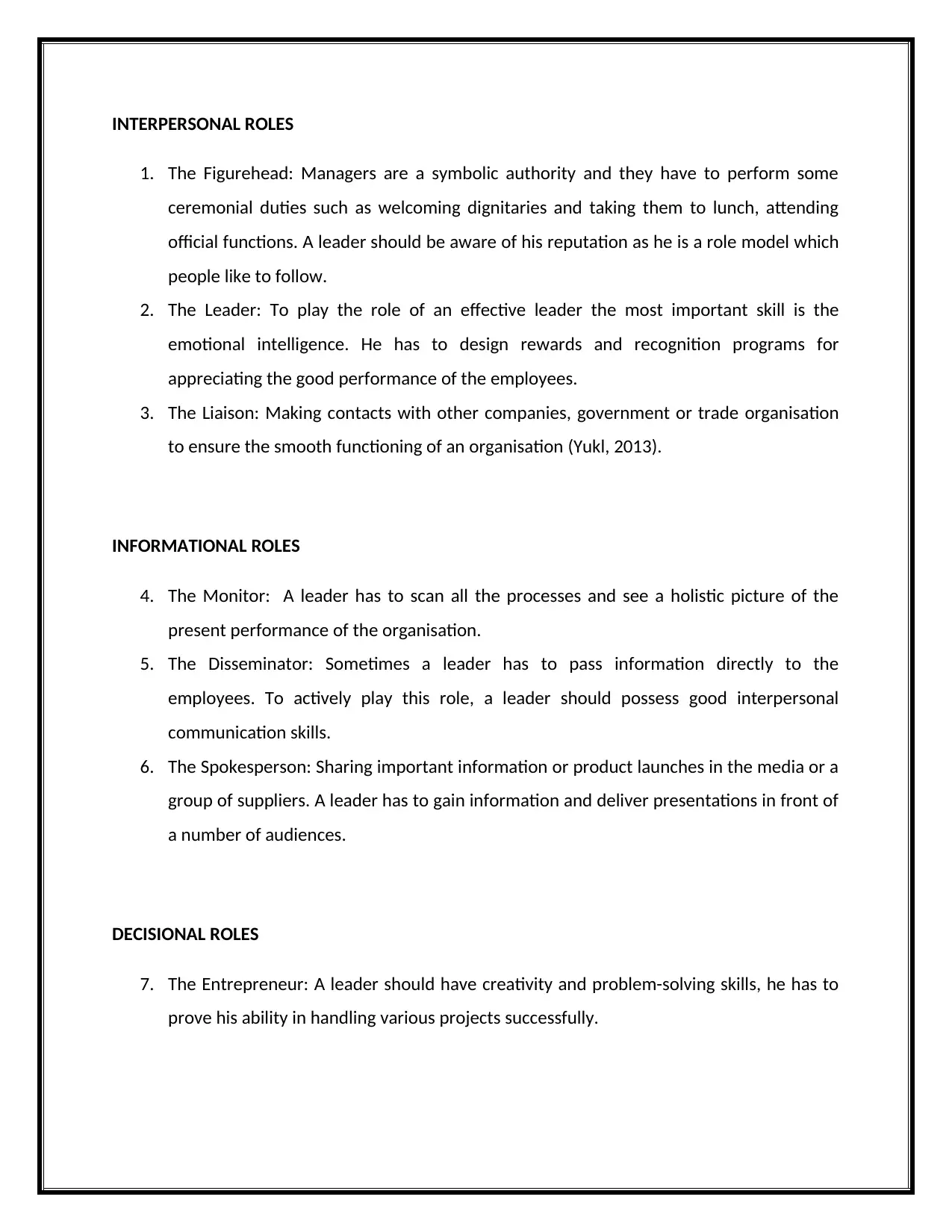
INTERPERSONAL ROLES
1. The Figurehead: Managers are a symbolic authority and they have to perform some
ceremonial duties such as welcoming dignitaries and taking them to lunch, attending
official functions. A leader should be aware of his reputation as he is a role model which
people like to follow.
2. The Leader: To play the role of an effective leader the most important skill is the
emotional intelligence. He has to design rewards and recognition programs for
appreciating the good performance of the employees.
3. The Liaison: Making contacts with other companies, government or trade organisation
to ensure the smooth functioning of an organisation (Yukl, 2013).
INFORMATIONAL ROLES
4. The Monitor: A leader has to scan all the processes and see a holistic picture of the
present performance of the organisation.
5. The Disseminator: Sometimes a leader has to pass information directly to the
employees. To actively play this role, a leader should possess good interpersonal
communication skills.
6. The Spokesperson: Sharing important information or product launches in the media or a
group of suppliers. A leader has to gain information and deliver presentations in front of
a number of audiences.
DECISIONAL ROLES
7. The Entrepreneur: A leader should have creativity and problem-solving skills, he has to
prove his ability in handling various projects successfully.
1. The Figurehead: Managers are a symbolic authority and they have to perform some
ceremonial duties such as welcoming dignitaries and taking them to lunch, attending
official functions. A leader should be aware of his reputation as he is a role model which
people like to follow.
2. The Leader: To play the role of an effective leader the most important skill is the
emotional intelligence. He has to design rewards and recognition programs for
appreciating the good performance of the employees.
3. The Liaison: Making contacts with other companies, government or trade organisation
to ensure the smooth functioning of an organisation (Yukl, 2013).
INFORMATIONAL ROLES
4. The Monitor: A leader has to scan all the processes and see a holistic picture of the
present performance of the organisation.
5. The Disseminator: Sometimes a leader has to pass information directly to the
employees. To actively play this role, a leader should possess good interpersonal
communication skills.
6. The Spokesperson: Sharing important information or product launches in the media or a
group of suppliers. A leader has to gain information and deliver presentations in front of
a number of audiences.
DECISIONAL ROLES
7. The Entrepreneur: A leader should have creativity and problem-solving skills, he has to
prove his ability in handling various projects successfully.
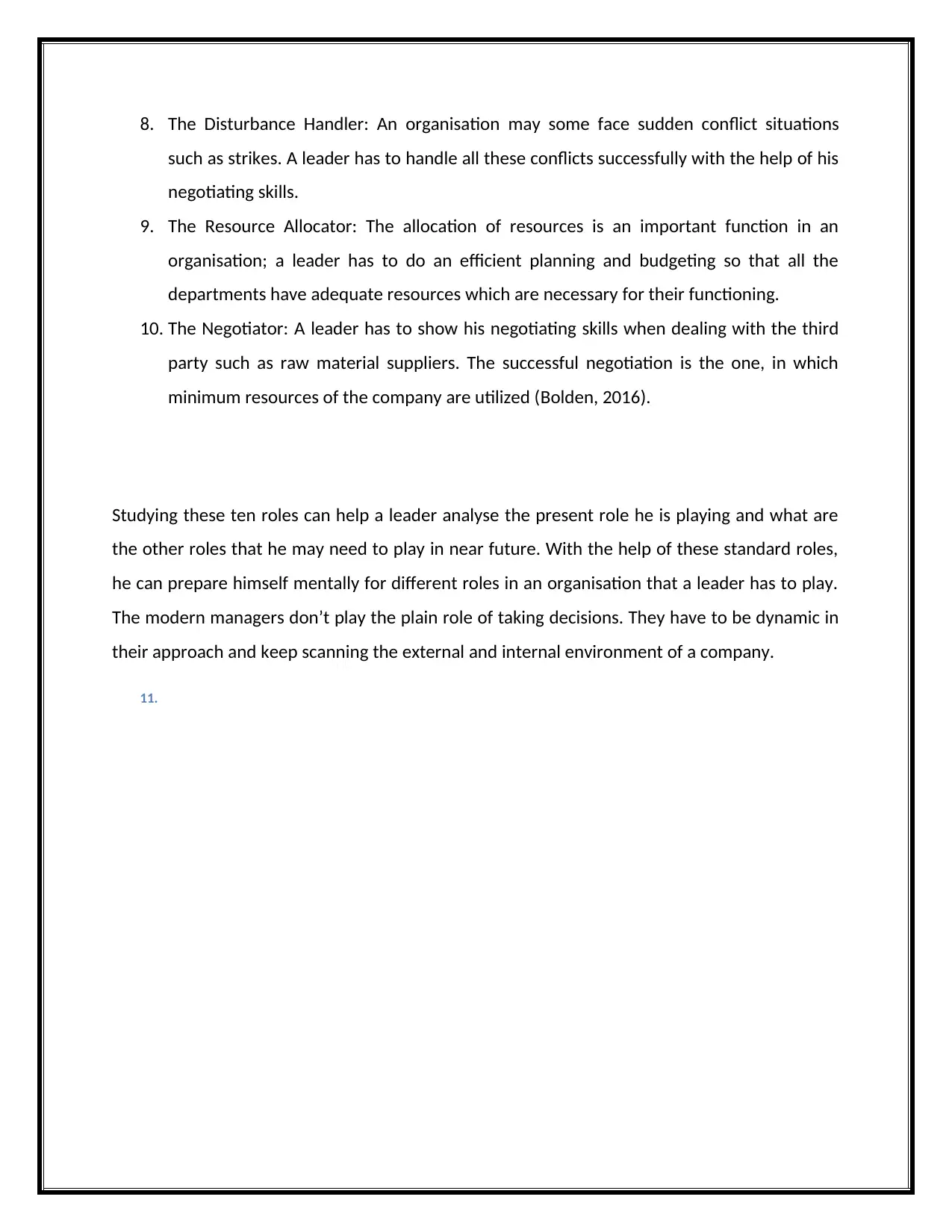
8. The Disturbance Handler: An organisation may some face sudden conflict situations
such as strikes. A leader has to handle all these conflicts successfully with the help of his
negotiating skills.
9. The Resource Allocator: The allocation of resources is an important function in an
organisation; a leader has to do an efficient planning and budgeting so that all the
departments have adequate resources which are necessary for their functioning.
10. The Negotiator: A leader has to show his negotiating skills when dealing with the third
party such as raw material suppliers. The successful negotiation is the one, in which
minimum resources of the company are utilized (Bolden, 2016).
Studying these ten roles can help a leader analyse the present role he is playing and what are
the other roles that he may need to play in near future. With the help of these standard roles,
he can prepare himself mentally for different roles in an organisation that a leader has to play.
The modern managers don’t play the plain role of taking decisions. They have to be dynamic in
their approach and keep scanning the external and internal environment of a company.
11.
such as strikes. A leader has to handle all these conflicts successfully with the help of his
negotiating skills.
9. The Resource Allocator: The allocation of resources is an important function in an
organisation; a leader has to do an efficient planning and budgeting so that all the
departments have adequate resources which are necessary for their functioning.
10. The Negotiator: A leader has to show his negotiating skills when dealing with the third
party such as raw material suppliers. The successful negotiation is the one, in which
minimum resources of the company are utilized (Bolden, 2016).
Studying these ten roles can help a leader analyse the present role he is playing and what are
the other roles that he may need to play in near future. With the help of these standard roles,
he can prepare himself mentally for different roles in an organisation that a leader has to play.
The modern managers don’t play the plain role of taking decisions. They have to be dynamic in
their approach and keep scanning the external and internal environment of a company.
11.
⊘ This is a preview!⊘
Do you want full access?
Subscribe today to unlock all pages.

Trusted by 1+ million students worldwide
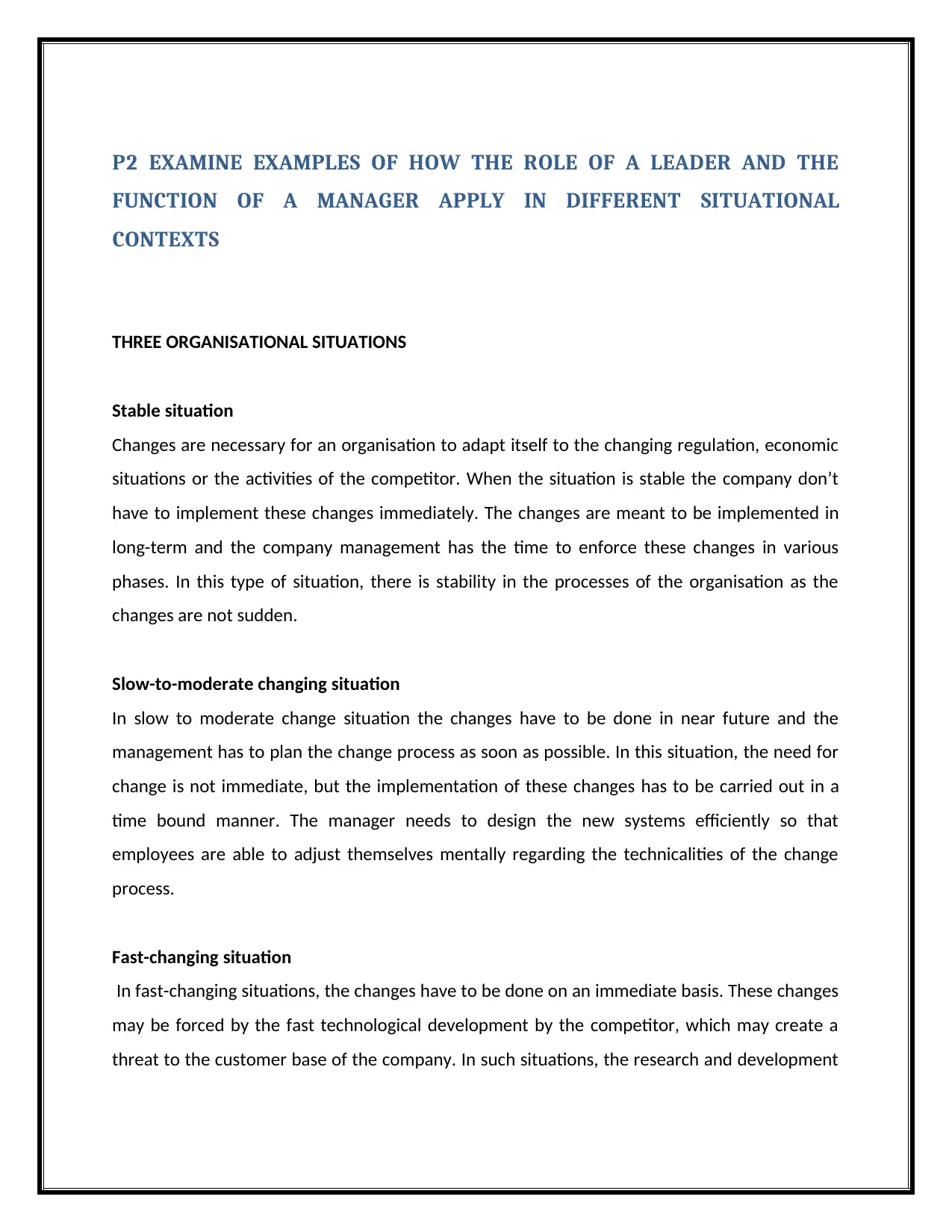
P2 EXAMINE EXAMPLES OF HOW THE ROLE OF A LEADER AND THE
FUNCTION OF A MANAGER APPLY IN DIFFERENT SITUATIONAL
CONTEXTS
THREE ORGANISATIONAL SITUATIONS
Stable situation
Changes are necessary for an organisation to adapt itself to the changing regulation, economic
situations or the activities of the competitor. When the situation is stable the company don’t
have to implement these changes immediately. The changes are meant to be implemented in
long-term and the company management has the time to enforce these changes in various
phases. In this type of situation, there is stability in the processes of the organisation as the
changes are not sudden.
Slow-to-moderate changing situation
In slow to moderate change situation the changes have to be done in near future and the
management has to plan the change process as soon as possible. In this situation, the need for
change is not immediate, but the implementation of these changes has to be carried out in a
time bound manner. The manager needs to design the new systems efficiently so that
employees are able to adjust themselves mentally regarding the technicalities of the change
process.
Fast-changing situation
In fast-changing situations, the changes have to be done on an immediate basis. These changes
may be forced by the fast technological development by the competitor, which may create a
threat to the customer base of the company. In such situations, the research and development
FUNCTION OF A MANAGER APPLY IN DIFFERENT SITUATIONAL
CONTEXTS
THREE ORGANISATIONAL SITUATIONS
Stable situation
Changes are necessary for an organisation to adapt itself to the changing regulation, economic
situations or the activities of the competitor. When the situation is stable the company don’t
have to implement these changes immediately. The changes are meant to be implemented in
long-term and the company management has the time to enforce these changes in various
phases. In this type of situation, there is stability in the processes of the organisation as the
changes are not sudden.
Slow-to-moderate changing situation
In slow to moderate change situation the changes have to be done in near future and the
management has to plan the change process as soon as possible. In this situation, the need for
change is not immediate, but the implementation of these changes has to be carried out in a
time bound manner. The manager needs to design the new systems efficiently so that
employees are able to adjust themselves mentally regarding the technicalities of the change
process.
Fast-changing situation
In fast-changing situations, the changes have to be done on an immediate basis. These changes
may be forced by the fast technological development by the competitor, which may create a
threat to the customer base of the company. In such situations, the research and development
Paraphrase This Document
Need a fresh take? Get an instant paraphrase of this document with our AI Paraphraser
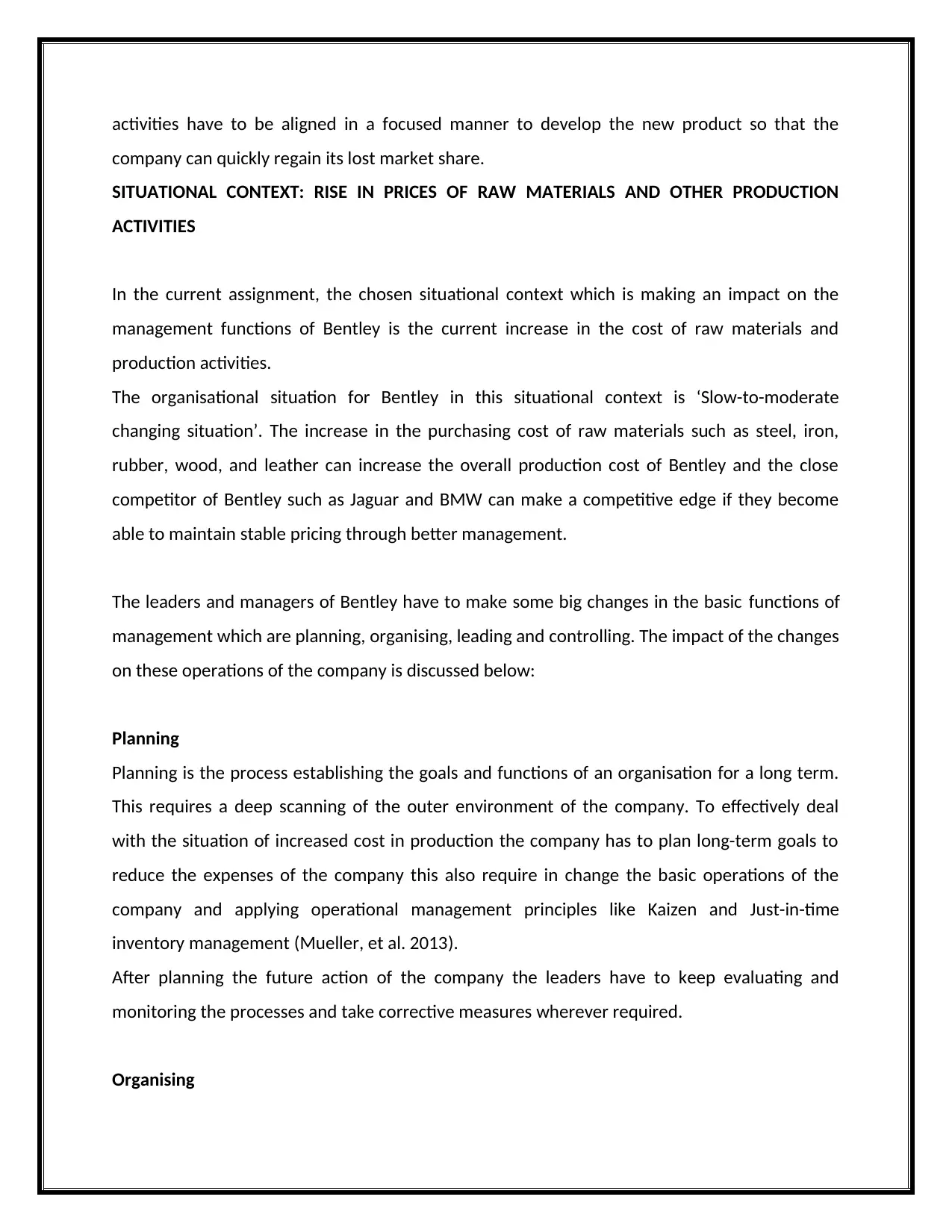
activities have to be aligned in a focused manner to develop the new product so that the
company can quickly regain its lost market share.
SITUATIONAL CONTEXT: RISE IN PRICES OF RAW MATERIALS AND OTHER PRODUCTION
ACTIVITIES
In the current assignment, the chosen situational context which is making an impact on the
management functions of Bentley is the current increase in the cost of raw materials and
production activities.
The organisational situation for Bentley in this situational context is ‘Slow-to-moderate
changing situation’. The increase in the purchasing cost of raw materials such as steel, iron,
rubber, wood, and leather can increase the overall production cost of Bentley and the close
competitor of Bentley such as Jaguar and BMW can make a competitive edge if they become
able to maintain stable pricing through better management.
The leaders and managers of Bentley have to make some big changes in the basic functions of
management which are planning, organising, leading and controlling. The impact of the changes
on these operations of the company is discussed below:
Planning
Planning is the process establishing the goals and functions of an organisation for a long term.
This requires a deep scanning of the outer environment of the company. To effectively deal
with the situation of increased cost in production the company has to plan long-term goals to
reduce the expenses of the company this also require in change the basic operations of the
company and applying operational management principles like Kaizen and Just-in-time
inventory management (Mueller, et al. 2013).
After planning the future action of the company the leaders have to keep evaluating and
monitoring the processes and take corrective measures wherever required.
Organising
company can quickly regain its lost market share.
SITUATIONAL CONTEXT: RISE IN PRICES OF RAW MATERIALS AND OTHER PRODUCTION
ACTIVITIES
In the current assignment, the chosen situational context which is making an impact on the
management functions of Bentley is the current increase in the cost of raw materials and
production activities.
The organisational situation for Bentley in this situational context is ‘Slow-to-moderate
changing situation’. The increase in the purchasing cost of raw materials such as steel, iron,
rubber, wood, and leather can increase the overall production cost of Bentley and the close
competitor of Bentley such as Jaguar and BMW can make a competitive edge if they become
able to maintain stable pricing through better management.
The leaders and managers of Bentley have to make some big changes in the basic functions of
management which are planning, organising, leading and controlling. The impact of the changes
on these operations of the company is discussed below:
Planning
Planning is the process establishing the goals and functions of an organisation for a long term.
This requires a deep scanning of the outer environment of the company. To effectively deal
with the situation of increased cost in production the company has to plan long-term goals to
reduce the expenses of the company this also require in change the basic operations of the
company and applying operational management principles like Kaizen and Just-in-time
inventory management (Mueller, et al. 2013).
After planning the future action of the company the leaders have to keep evaluating and
monitoring the processes and take corrective measures wherever required.
Organising
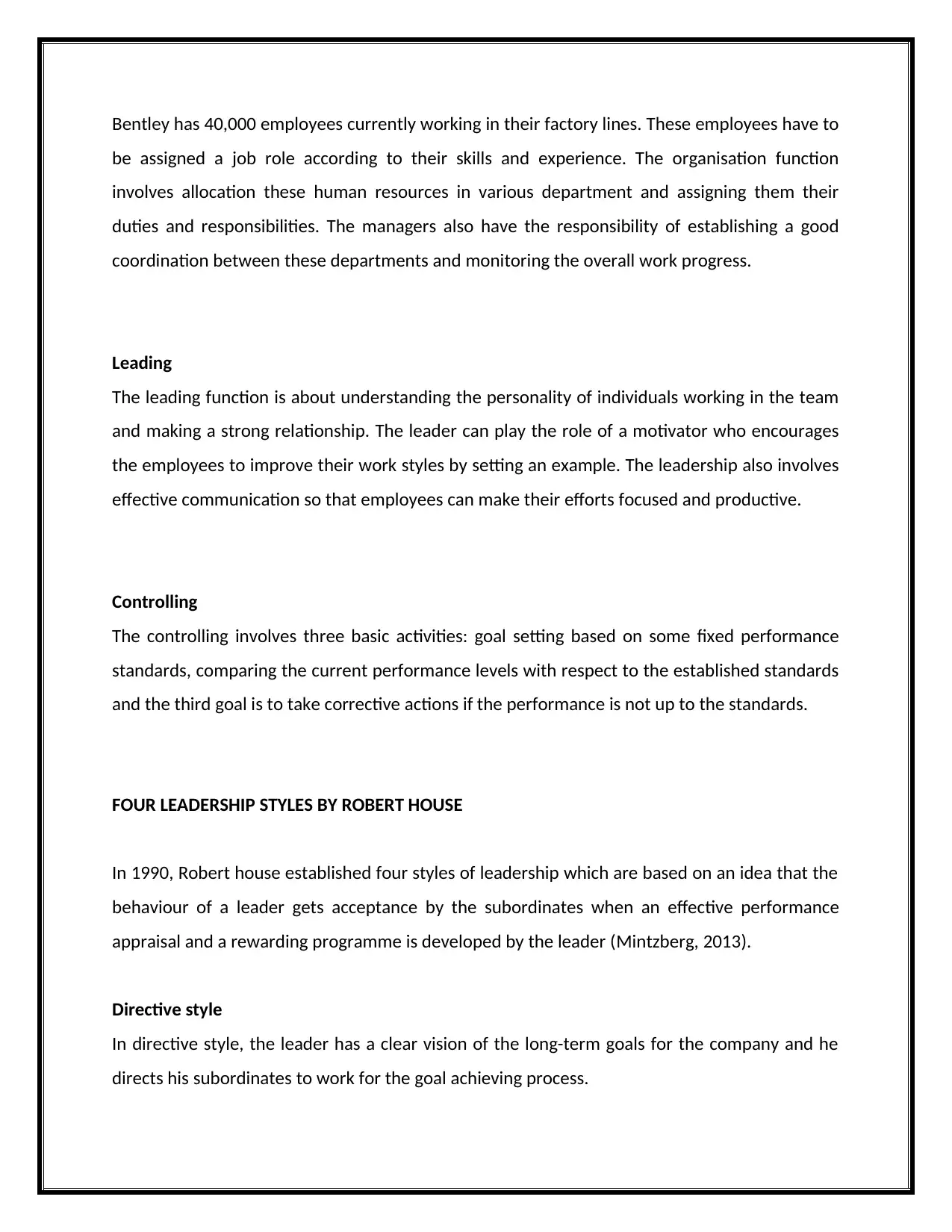
Bentley has 40,000 employees currently working in their factory lines. These employees have to
be assigned a job role according to their skills and experience. The organisation function
involves allocation these human resources in various department and assigning them their
duties and responsibilities. The managers also have the responsibility of establishing a good
coordination between these departments and monitoring the overall work progress.
Leading
The leading function is about understanding the personality of individuals working in the team
and making a strong relationship. The leader can play the role of a motivator who encourages
the employees to improve their work styles by setting an example. The leadership also involves
effective communication so that employees can make their efforts focused and productive.
Controlling
The controlling involves three basic activities: goal setting based on some fixed performance
standards, comparing the current performance levels with respect to the established standards
and the third goal is to take corrective actions if the performance is not up to the standards.
FOUR LEADERSHIP STYLES BY ROBERT HOUSE
In 1990, Robert house established four styles of leadership which are based on an idea that the
behaviour of a leader gets acceptance by the subordinates when an effective performance
appraisal and a rewarding programme is developed by the leader (Mintzberg, 2013).
Directive style
In directive style, the leader has a clear vision of the long-term goals for the company and he
directs his subordinates to work for the goal achieving process.
be assigned a job role according to their skills and experience. The organisation function
involves allocation these human resources in various department and assigning them their
duties and responsibilities. The managers also have the responsibility of establishing a good
coordination between these departments and monitoring the overall work progress.
Leading
The leading function is about understanding the personality of individuals working in the team
and making a strong relationship. The leader can play the role of a motivator who encourages
the employees to improve their work styles by setting an example. The leadership also involves
effective communication so that employees can make their efforts focused and productive.
Controlling
The controlling involves three basic activities: goal setting based on some fixed performance
standards, comparing the current performance levels with respect to the established standards
and the third goal is to take corrective actions if the performance is not up to the standards.
FOUR LEADERSHIP STYLES BY ROBERT HOUSE
In 1990, Robert house established four styles of leadership which are based on an idea that the
behaviour of a leader gets acceptance by the subordinates when an effective performance
appraisal and a rewarding programme is developed by the leader (Mintzberg, 2013).
Directive style
In directive style, the leader has a clear vision of the long-term goals for the company and he
directs his subordinates to work for the goal achieving process.
⊘ This is a preview!⊘
Do you want full access?
Subscribe today to unlock all pages.

Trusted by 1+ million students worldwide
1 out of 28
Related Documents
Your All-in-One AI-Powered Toolkit for Academic Success.
+13062052269
info@desklib.com
Available 24*7 on WhatsApp / Email
![[object Object]](/_next/static/media/star-bottom.7253800d.svg)
Unlock your academic potential
Copyright © 2020–2025 A2Z Services. All Rights Reserved. Developed and managed by ZUCOL.





